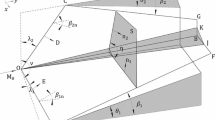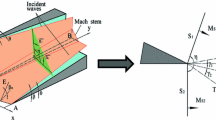Abstract
This paper explores theoretical solutions to the three-dimensional (3D) shock/shock interaction induced by 3D asymmetrical intersecting compression wedges in supersonic inviscid flows. For Mach interactions, an analytical method known as spatial-dimension reduction, which transforms the problem of 3D steady shock/shock interaction into a two-dimensional (2D) pseudo-steady problem on cross sections, is used to obtain the solutions in the vicinity of the Mach stem. The theoretical solutions include the pressure, temperature, density, Mach number behind the Mach stem, and total pressure recovery coefficient. Numerical simulations are performed to validate the theoretical results. Here, the NND scheme is employed by solving 3D inviscid Euler equations, and good agreements are obtained. The asymmetry of the flow characteristics induced by the wedge angle and sweep angle are thoroughly discussed.
Similar content being viewed by others
References
Charwat A F, Redekeopp L G. Supersonic interference flow along the corner of intersecting wedges. AIAA J, 1967, 5: 480–488
Cresci R J, Lin T C, Nardo C T, et al. Hypersonic interaction along a rectangular corner. AIAA J, 1969, 7: 2241–2246
Watson R, Weinstein L. A study of hypersonic corner flow interactions. AIAA J, 1971, 9: 1280–1286
West J E, Korkegi R H. Interaction of the corner of intersecting wedges at a Mach number of 3 and high Reynolds numbers. AIAA J, 1972, 10: 652–656
Stainback P C, Weinstein L M. Aerodynamic Heating in the Vicinity of Corners at Hypersonic Speeds. Washington D. C.: Natl Aeronautics Space Administration, 1967
Korkegi R H. Survey of viscous interactions associated with high Mach number flight. AIAA J, 1971, 9: 771–784
Venkateswaran S, Witte D W, Hunt L R. Aerothermal study in an axial compression corner with shock impingement at Mach 6. AIAA Paper No. 91–0527, 1991
Rubin S G. Incompressible flow along a corner. J Fluid Mech, 1966, 26: 97–110
Kutler P. Supersonic flow in the corner formed by two intersecting wedges. AIAA J, 1974, 12: 577–578
Shang J S, Hankey W L, Petty J S. Three-dimensional supersonic interacting turbulent flow along a corner. AIAA J, 1979, 17: 706–713
Marconi F. Supersonic, inviscid, conical corner flowfields. AIAA J, 1980, 18: 78–84
Ambrosio D, Marsilio R. Shock-induced separated structures in symmetric corner flows. NASA Langley Research Center. Institute for Computer Applications in Science and Engineering [ICASE], ICASE Report, 1995. 79–95
Goonko Y P, Kudryavtsev A N, Chpoun A. 3D interaction of shock waves in corner flow. Berlin: Shock Waves, Springer Berlin Heidelberg, 2005. 437–442
Goonko Y P, Kudryavtsev A N, Rakhimov R D. Supersonic inviscid corner flows with regular and irregular shock interaction. Fluid Dyn, 2004, 39: 304–318
Goonko Y P, Kudryavtsev A N. Numerical modelling of free interaction of shock waves in corner flows. Thermophys Aeromechanics, 2006, 13: 221–237
Ning J G, Wang X, Ma T B, et al. Numerical simulation of shock wave interaction with a deformable particle based on the pseudo arc-length method. Sci China Tech Sci, 2015, 58: 848–857
Hongzhi L I, Baochun F A N, Jihui G, et al. Shock wave interaction with surface of combustible dust layers. Sci China Ser E-Tech Sci, 1996, 39: 449–460
Von Neumann J. Refraction, intersection and reflection of shock waves. NAVORD Rep, 1945, 1: 203–245
von Neumann J. Oblique Reflection of Shock Waves, Collected Work of Von Neumann, John. Oxford: Pergamon Press, 1996. 145: 44–46
Kawamura R, Saito H. Reflection of shock waves–1 Pseudo-stationary case. J Phys Society Japan, 1956, 11: 584–592
Ben-Dor G. Shock Wave Reflection Phenomena. Berlin: Springer, 2007
Yang Y. The investigations on complex flow of three dimensional shock/shock interaction (in Chinese). Dissertation of Doctor Degree. Beijing: Chinese Academy of Sciences, 2012
Xiang G, Wang C, Teng H, et al. Study on Mach stems induced by interaction of planar shock waves on two intersecting wedges. Acta Mechanica Sinica, 2015, doi: 10.1007/s10409-015-0498-2
Yang Y, Wang C, Jiang Z L. Analytical and numerical investigations of the reflection of asymmetric nonstationary shock waves. Shock Waves, 2012, 22: 435–449
Xiang G X, Wang C, Teng H H, et al. Investigations of three-dimensional shock/shock interactions over symmetrical intersecting wedges. AIAA J, 2016, doi:10.2514/1.J054672
Xie P, Han Z Y, Takayama K. A study of the interaction between two triple points. Shock Waves, 2005, 14: 29–36
Zhang H X. A dissipative difference scheme of non-oscillatory, nofree parameters (in Chinese). Acta Aerodynamica Sinica, 1988, 6: 143–165
Author information
Authors and Affiliations
Corresponding author
Rights and permissions
About this article
Cite this article
Xiang, G., Wang, C., Hu, Z. et al. Theoretical solutions to three-dimensional asymmetrical shock/shock interaction. Sci. China Technol. Sci. 59, 1208–1216 (2016). https://doi.org/10.1007/s11431-016-6036-z
Received:
Accepted:
Published:
Issue Date:
DOI: https://doi.org/10.1007/s11431-016-6036-z




